5 Groundbreaking Chairs Designed by Architects
For architects, a chair is not just something to sit on, but a kind of miniature building, a fusion of form and function that must not only look good, but be structurally sound. “A chair is a very difficult object,” said Ludwig Mies van der Rohe. “A skyscraper is almost easier. That is why Chippendale is famous.” From the feather-light chairs of Gio Ponti to the sinuous seating of Frank Gehry, join us for a look at five groundbreaking chairs designed by Architects.
Gio Ponti (1891-1979)
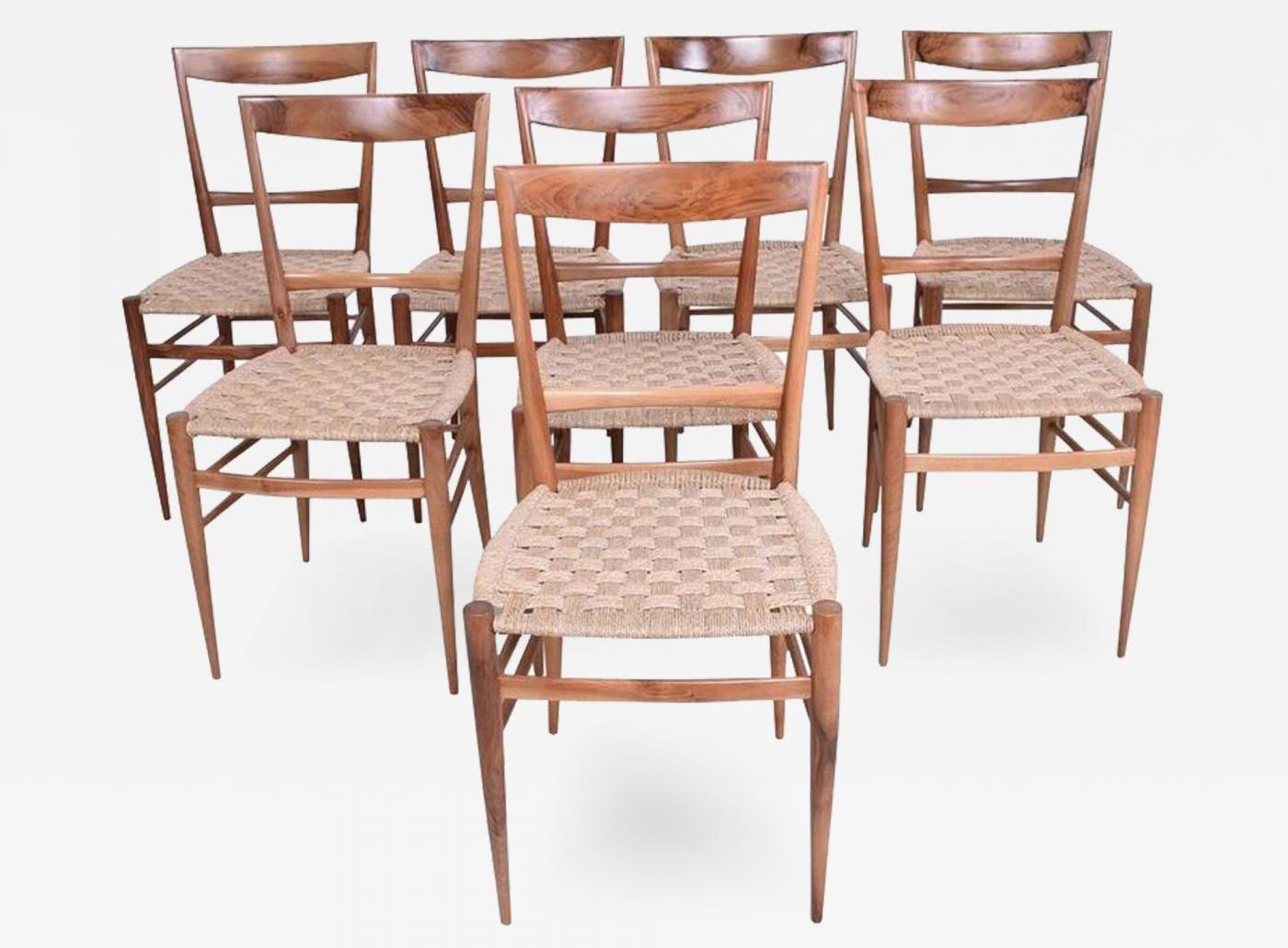
- Gio Ponti (Attributed), Set of Eight Italian Superleggera Dining Chairs, c. 1950s. Walnut and seagrass weave. Offered by AMBIANIC (National City, Calif.).
Gio Ponti was a man of many talents: architect, furniture maker, scholar, and writer. He began his career by designing ceramics with neoclassical motifs on behalf of Richard Ginori, the legendary workshop on the outskirts of Florence founded in 1735, but later adopted an ascetic sensibility in harmony with the precepts of minimalism. This is perhaps best illustrated by the Pirelli Tower, a 33-story skyscraper in central Milan that was constructed with 30,000 cubic meters of pre-stressed, reinforced concrete. Apart from his work in architecture and design, Ponti was editor of Domus magazine from 1928 to 1941 (and again from 1948 to 1979), bringing intellectual heft to the field of design by analyzing the discipline in the context of contemporary culture. The charismatic designer was the unofficial mayor of Milan, tootling around the city in a Citroën DS.
In 1957, Ponti designed the Superleggera (Italian for “super-light”) on behalf of Cassina. This design signaled a break from the ponderous seating of a previous era, a portable chair that was so light it could be lifted by a boy on the tip of his finger (as shown in promotional materials). The Superleggera also reflected a democratization of the market, a well-made piece with walnut frame and artisanal weave that was within reach of middle-class buyers. Today, authenticated Superleggera chairs are highly sought after by collectors.
Frank Gehry (b. 1929)
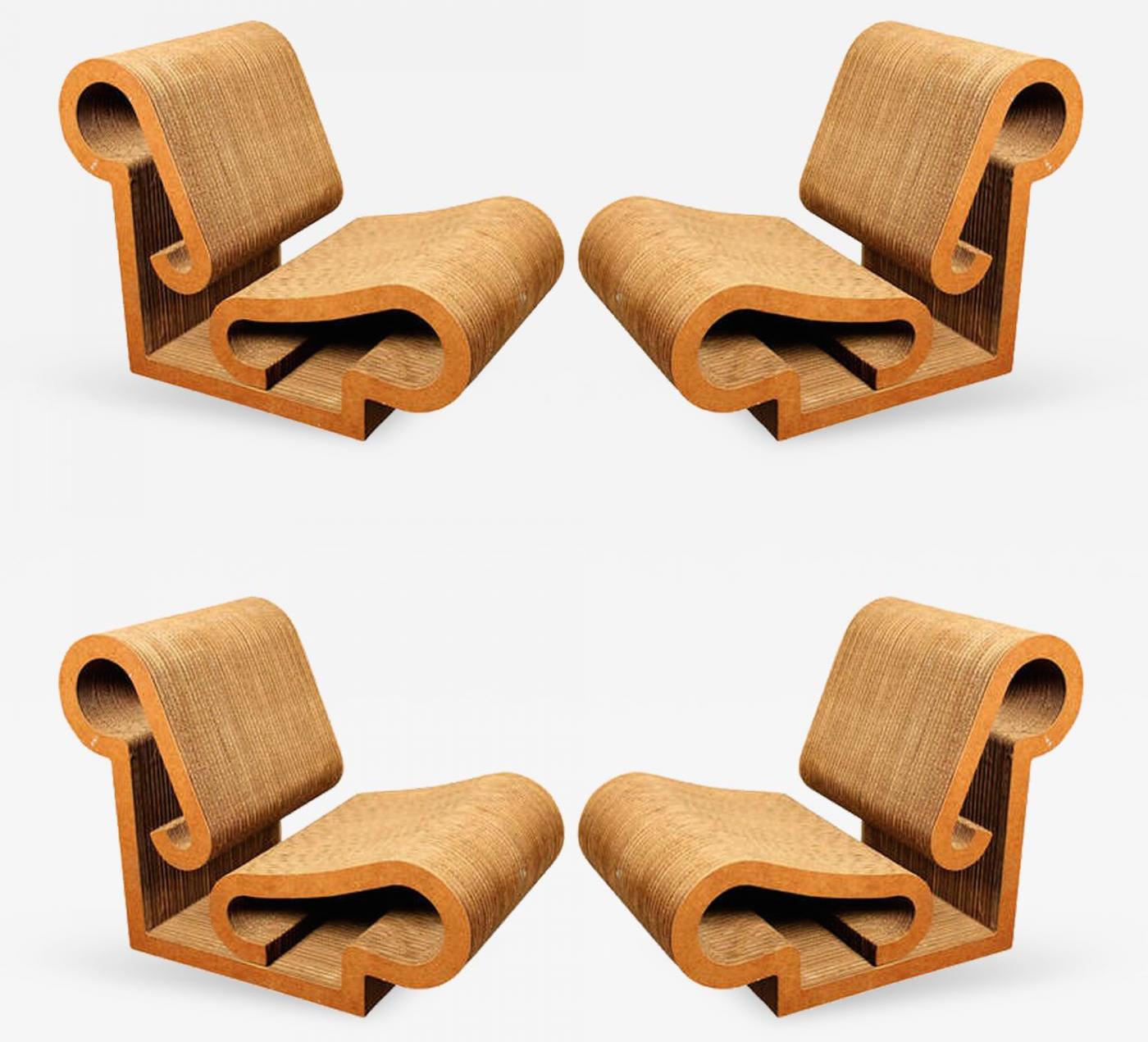
- Frank Gehry, Rare Set of Four “Contour” Lounge Chairs, 1973. Corrugated cardboard and masonite. Offered by Bermingham & Co. (New York City).
Perhaps the most influential architect living today, Frank Gehry is renowned for flamboyant designs clad in stainless steel or titanium, such as the Guggenheim Museum Bilbao. This celebrated building is a feat of Deconstructivism, with curvilinear walls meant to “catch the light,” according to the architect. The 350,000-square-foot edifice has been compared to a seafaring vessel docked on the banks of the Nervión River, “a fantastic dream ship of undulating form in a cloak of titanium,” in the words of the art critic Calvin Tomkins.
In the context of furniture, Gehry has won plaudits for his sinuous seating, such as this rare set of four “Contour” lounge chairs, from Bermingham & Co. (New York City). In this series, the artist is mixing registers, deploying humble or industrial materials in the service of cutting-edge design. The chairs are impossible to classify, but, then, Gehry has never cared much about playing by the rules, once remarking at a press conference, “In the world we live in, ninety-eight per cent of what gets built and designed today is pure shit. There’s no sense of design nor respect for humanity or anything. They’re bad buildings and that’s it.”
Frank Lloyd Wright (1867-1959)
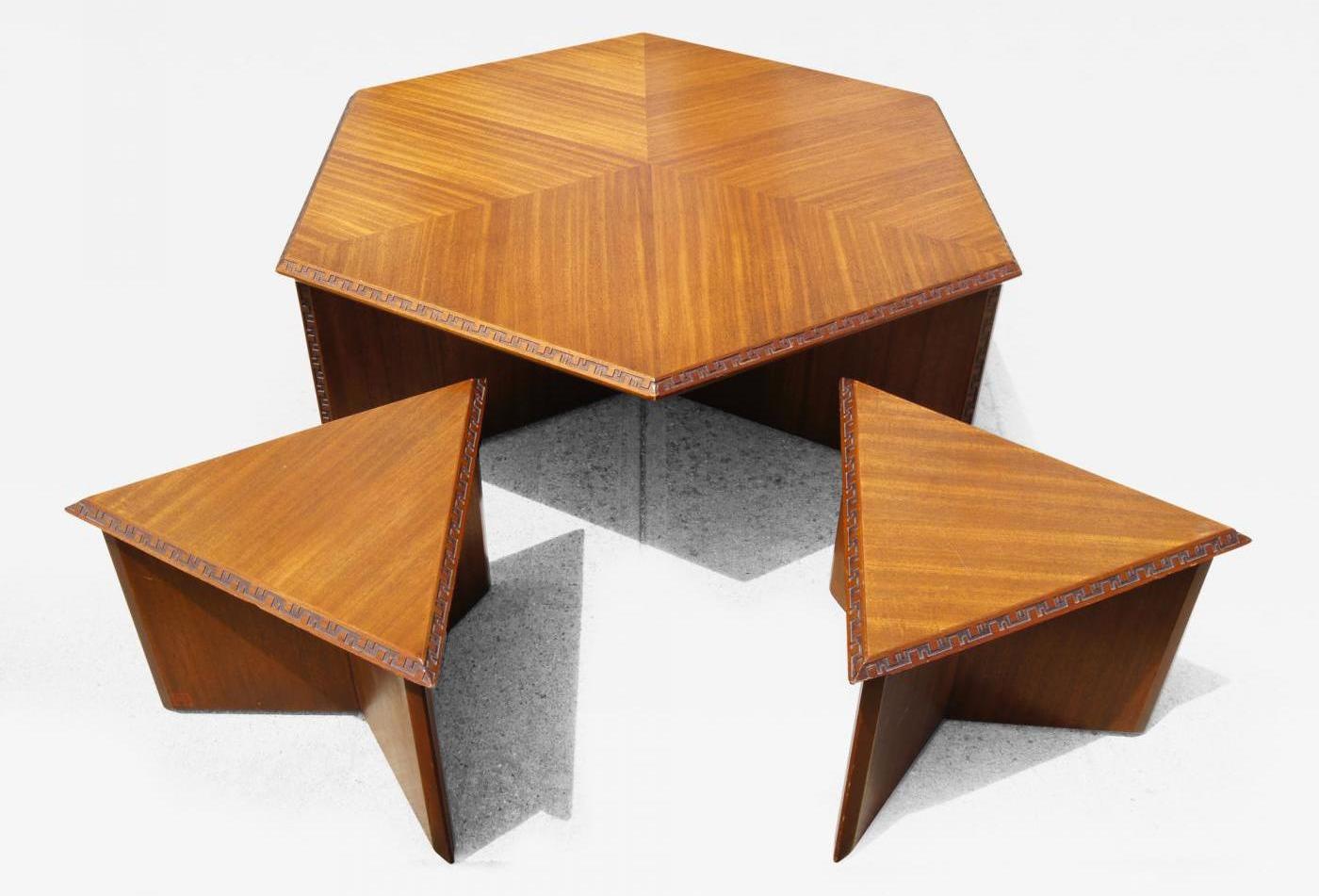
- Frank Lloyd Wright, Hexagonal Coffee Table Set, 1955. Carved mahogany. Offered by Machine Age (Boston).
It is hard to overstate the influence of Frank Lloyd Wright, progenitor of the Prairie School and evangelist of “organic architecture.” Not only is he the subject of a 1970 ballad by the folk duo Simon & Garfunkel, but Wright was hailed in 1991 by the American Institute of Architects as “the greatest American architect of all time.” Oak Park, Ill., is, in effect, a town-sized shrine to the builder, with row upon row of Prairie-style houses.
Wright practiced a holistic approach to art and architecture and cared as much about the interior elements of a building—oak furniture, incandescent lighting, stained glass—as the building itself. In some ways, his professional philosophy was an American version of the German concept of Gesamtkunstwerk, or the seamless integration of architecture and design. In a 1910 manifesto on the subject, Wright declared that his mission was to “make of a dwelling place a complete work of art … This is the modern American opportunity.”
Wright was also a shrewd businessman, and, in the 1950s, he reached an agreement with Henredon to produce a series of furniture named for Taliesin, the architect’s 800-acre compound near Spring Green, Wis. From the moment it was announced, the Heritage-Henredon collection was hailed as a gift to the American consumer, with a reporter for the Detroit Free Press writing, “The most talked-about furniture in decades is the furniture designed for ordinary, everyday people—by Frank Lloyd Wright. The venerable gentleman… has been proclaimed by many as the greatest architect of the past 500 years and compared to the versatile genius Leonardo da Vinci.”
Like other pieces in the Heritage-Henredon collection, the Hexagonal Coffee Table Set (1955), offered by Machine Age (Boston), is characterized by geometric shapes, with two triangular tools that fit snugly under a hexagonal top mounted on a tripod base. The much-ballyhooed collection was not a commercial success at first, but it is now prized by furniture and design enthusiasts.
Ludwig Mies van der Rohe (1886-1969)
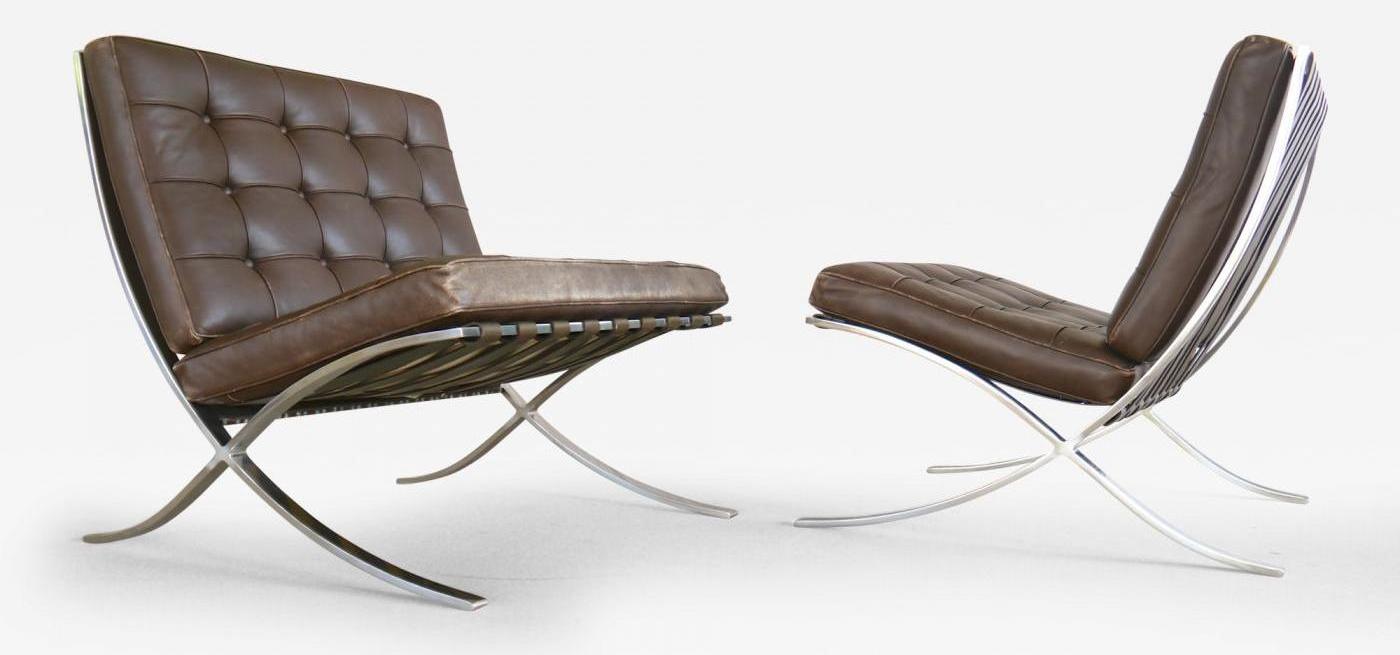
- Ludwig Mies van der Rohe, Exceptional Pair of Barcelona Chairs, c. 1960s. Stainless steel and leather. Offered by Continuum 20th Century Design (Amherst, Mass.).
The builder behind many of the sleek skyscrapers of the Chicago skyline is the German-born Ludwig Mies van der Rohe, one of the best-known proponents of the International Style. The son of a stonemason, Mies arrived at architecture by way of furniture design, serving as an apprentice to Bruno Paul, a master of Art Nouveau. Together with Walter Gropius and Le Corbusier, Mies was one of the principal artists associated with the Bauhaus school, a crucible of minimalism in the early twentieth century.
At the 1929 International Exposition at Barcelona, Mies rose to international fame with his design for the German Pavilion, a free-flowing space with walls of green Tinian marble, honey-colored onyx and frosted glass. In conjunction with this project, Mies designed the Barcelona series, an iconic collection that has come to be synonymous with modern furniture. With dimpled leather cushions and slender chrome-plated legs, it is also a favorite of collectors, with examples on offer at TFTM (Los Angeles), Collection 20c (New York), The Exchange Int (Houston), Continuum 20th Century Design (Amherst, Mass.), and AMBIANIC (National City, Calif.).
Alvar Aalto (1898-1976)
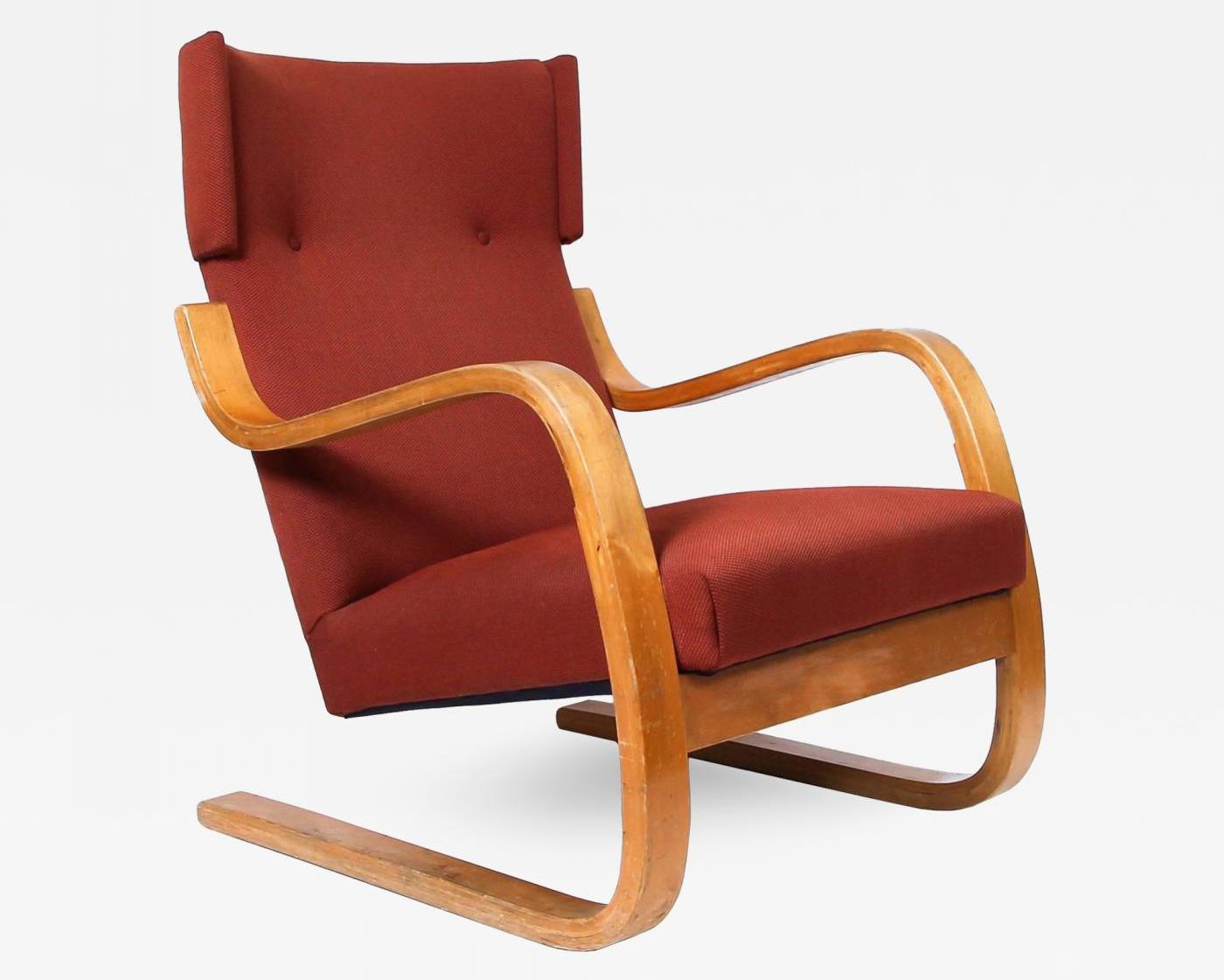
- Alvar Aalto, Early Cantilevered Armchair, Model 36/86, c. 1930s. Wool fabric and birch laminated plywood. From The Exchange Int (Houston).
Across the Baltic Sea, a cadre of designers and architects seized on the principles of the International Style to move away from the classicism that had defined Nordic architecture during the first part of the twentieth century. Foremost among them was Alvar Aalto, who integrated certain elements of the Bauhaus—ribbon windows, flat roofs, undifferentiated white surfaces—into early building designs like the tuberculosis sanatorium at Paimio. Aalto strived for a spontaneous approach, sketching preliminary designs without the aid of a T-square and triangle.
As his career progressed, Aalto adopted a more expressive style, softening the clinical aesthetic of modernism with skylights, free architectural forms, and elements of organic design. This shift extended to his furniture, where he made use of warm and natural materials. Aalto was the first furniture maker to use the cantilever principle, associated with the Brno chairs of Ludwig Mies van der Rohe, to create wooden pieces like a Tank Chair upholstered in leather, from Liz O’Brien (New York); and the Early Cantilevered Armchair, Model 36/86, from The Exchange Int.
For more on the intersection of architecture and furniture design, see:
Top 11 Frank Lloyd Wright Houses You Can Tour
11 Scandinavian Modern Design Pioneers Whose Creations Will Always Be In Style
6 Best Design Museums in Europe































